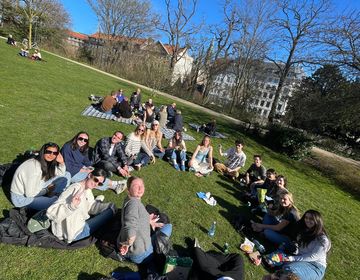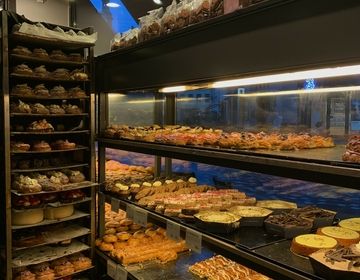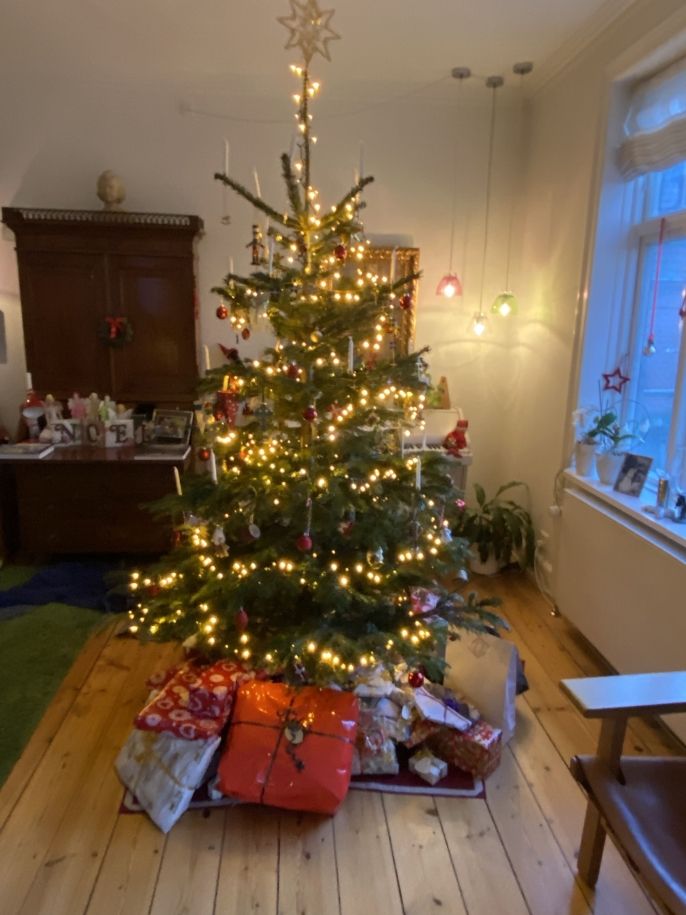6 Tips to Immerse Yourself in Danish Culture - Christmas Edition!
In August we wrote a blog post with six different tips on how to immerse yourself in Danish culture while you’re studying with us in Copenhagen. This time around, we’re giving you a guide on how to do the same in December, the most wonderful “hyggelig” time of the year here in Denmark!
1. “Glædelig jul!”
First off – the basics. The Danish word for Christmas is “jul”, which comes from the Old Norse word “jól” or “jólablót”, the pre-Christian pagan tradition of winter solstice. “Jól” is also where the old English word “Yule” comes from.
Therefore, if you want to wish someone a merry Christmas, you say “glædelig jul” or, perhaps easier for foreigners to say, “god jul”. You can also throw in a “og godt nytår” (and a happy New Year) for the fun of it.
Santa in Danish isn’t called Santa either, he is called “julemanden”, which directly translates to, you guessed it, “the Christmas man” (we are nothing if not creative in Denmark). In Danish tradition he doesn’t live on the North Pole, but in Greenland, where his workshop is. He doesn’t have any elves either, but “nisser”, which are quite similar with a couple of exceptions: Nisser are typically short with long white beards, wearing a conical or knit cap, typically in red.
In Denmark, we also don’t celebrate Christmas Day, only Christmas Eve, where we gather with family and have a massive feast with pot roast, duck, 15 different types of potatoes, sauce and red kale and rice pudding with cherry sauce for dessert. Then we dance around the Christmas tree, or rather, walk around hand in hand singing songs, and lastly, we open our presents before falling exhausted and full into bed well past midnight.
2. Get into the Julehygge of Things
Another good word to know is “julehygge”, or Christmas hygge, and there are several different ways to experience that around Copenhagen during December.
First off, you could go to a Christmas market and have gløgg and æbleskiver. Gløgg or glögg or however you want to spell it (just, please, not “glogg”) is the Danish/Swedish take on the mulled wine that spread to the North of Europe from Germany at the start of the 20th century (In Germany, the drink is known as “Glühwein” – literally “glow wine”). Gløgg can be made in a manner of different ways, but typically it’s warm red wine and sometimes even cognac or another alcoholic drink (yes, gløgg is very strong, don’t drink too much of it) with sliced almonds, raisins and sometimes even orange peel in it. Spices are also an important part of the mix, the most common ones being cloves, cinnamon, cardamom and ginger.
Æbleskiver, the baked Christmas companion to gløgg, is almost like a round pancake made on pans with holes in them (google “æbleskivepande”). The word “æbleskiver” directly translates to “apple slices”, which is a bit dated, as there is nothing but dough and calories in them today, but back in the olden days æbleskiver were typically made with actual apple slices hiding inside them. Today however, you typically serve them with jam and “flormelis” (powdered sugar) on the side – and gløgg too, of course.
You could also try to bake some classic Danish Christmas treats and cookies, like “klejner”, a type of fried pastry, “finskbrød” (Finnish bread), a cookie with granulated sugar on top, “pebernødder”, small round cinnamon cookies, or “konfekt”, chocolate-covered marzipan and nougat treats.
3. Watch a “Julekalender” or Christmas Calendar
Another classic Danish Christmas activity you could engage in is watch a Christmas calendar, or a “julekalender”.
In Denmark, both kids and adults alike are glued to their TV-screens from 7-8 pm every day from the 1st to the 24th of December, because that’s typically when the annual Christmas calendars air on the TV networks DR and TV2. A Christmas calendar is a TV series in 24 parts, each episode roughly 30 minutes in total, where a new episode is dropped every day leading up to Christmas eve – the best countdown ever.
Famous Christmas calendars include “Pagten” (The Pact), about a human boy and a nisse girl working together to save all the nisser from an evil ice witch, “Jul i Valhal” (Christmas in Valhalla), about two kids accidentally freeing Loki from his prison and starting Ragnarok, and “Nissebanden i Grønland” (The Nisse-Gang in Greenland), about a group of elves trying to save Christmas after Santa mysteriously goes missing.
If finding Christmas Calendars with English dubbing or subtitles proves too difficult, you could alternatively try watching “The Julekalender”, wacky and comedic Christmas calendar about three elves who, after spending a considerable amount of time in America, comes back to rural Jutland in order to ward off a threat to all elf or “nisse”-kind. The best part is that you won’t have to find the series with English subtitles, as the elves speak a strange Danish-English hybrid language where you with relative ease could be able to pick up on at least some of it, and be able to guess the rest from context (try YouTubing the songs “It’s Hard to be a Nissemand” or “Støvledans” if you want a nice little laugh at their hilarious antics).
4. Watch a Sankta Lucia Parade
Yes, we know celebrating Sankta Lucia technically is Swedish, but the tradition has grown to be almost just as celebrated here in Copenhagen.
Sankta Lucia, or Saint Lucy, was a Christian martyr from the Italian island of Sicily during Roman times who refused to get married due to her wish of remaining a virgin after she had had an epiphany from God. When the man her mother had promised her to, found out about this, he turned her in to the authorities. At this point in time, it was still a punishable offense to be Christian, and so she was convicted to be burned at the stake. However, when the time came for the guards to take her away, she couldn’t be moved, not even by a herd of cattle. Not even the guards taking out her eyes seemed to sway her. Therefore, as a last resort, the executioner had to behead her. Today, Sankta Lucia is the patron saint of the blind, and she is often depicted with her eyes in a small bowl or on a platter in front of her.
She is celebrated every year on the 13th of December in the Nordics with a Sankta Lucia Parade, where a succession of young girls in white with silver in their hair, holding candles, led by the Lucia bride with a wreath of candles in her hair march through schools, nursery homes, churches and more, singing the Lucia song and other Christmas carols. In Sweden, it is also customary to eat “lussekatter”, a golden bun with saffron and raisins in them, on the morning of the 13th.
5. Try Your Hand at some Danish Christmas Crafts
In Denmark we looooove to “juleklippeklistre” (yes that’s a word) or do Christmas crafts. In Denmark we like to make “julehjerter” – Christmas hearts. These braided paper Christmas hearts that you can decorate your tree with are native to Denmark, since they were supposedly invented in the 1860’s by Danish author and very accomplished paper artist Hans Christian Andersen, the very same who wrote classics like “The Little Mermaid” or “The Ugly Duckling”.
You could also try making “kræmmerhuse”, a paper cone you fill with treats and pebernødder, long paper garlands to wrap around your Christmas tree or, if you feel like a challenge, a “julestjerne” (Christmas star), four strips of paper braided together to form a nice star you can put on a wrapped gift or your tree.
6. Build the ultimate Danish Christmas playlist
Lastly, you can also create the ultimate Christmas playlist filled with all kinds of classic Danish Christmas songs – the old, the new and the borderline blasphemous (all in good spirit, though). Here are a couple of recommendations:
1. The old: “Det kimer nu til julefest” ([The bells] now chime for a Christmas celebration)
One of the classic “julesalmer”, or Christmas songs, “Det kimer nu til julefest” is often one of the songs sung by young and old alike when Danes dance (walk) around their Christmas trees on Christmas Eve. The lyrics are written by the priest and poet N. F. S. Grundtvig, a towering figure in Danish cultural history and a name that seems to pop up everywhere around Christmastime in Denmark.
Quote: “It [the bells] now chime for the guest from up high / who stooped to low huts / bringing new year’s presents, joy and peace.”
2. The old school: “Den himmelblå” (The Sky Blue) – Shu-Bi-Dua
A good ol’ classic from the merry 80’s, “Den himmelblå” is a Christmas song by the iconic Danish band Shu-Bi-Dua, known for their wit, humor and tendency to have fun with the Danish language.
Quote: “Jesus is born on the second floor / Of Magasin du Nord / He laughs when you step on a foot pedal / Says hello to his mother.”
3. The new: “Der’ noget i december” (There’s something about December) – Rasmus Seebach
You can’t talk about Danish pop in the 2000’s and early 2010’s without mentioning Rasmus Seebach. His songs are catchy, easily digestible, don’t offend anyone and are also really sweet, and “Der’ noget i december” is no exception. The song is about Christmastime in Denmark and what that makes him feel – like it’s time for him and his loved one to start a family. Very cute.
Quote: “There’s something about December / that sort of reminds me about / what really matters / I was young and naïve but you get older / And understand.”
4. The weird and wacky: “Jesus & Josefine” – Julie and Martin Brygmann
Yes, you read correctly, this is a song about Jesus – to some degree. “Jesus & Josefine” is from a Christmas calendar (see no. 3) of the same name about a 13-year-old Danish girl who accidentally travels back in time, where she meets and falls in love with teenage Jesus. Yes – this is a real Danish kids TV show. We’re not kidding. Google it for yourself.
Quote: “Shepherds and angels, and three wise men / Fate wills her to go there / Where she meets a king, a saviour, a guy / Christmas will be like a fairytale this year!”
5. The “oh my god is this really meant for kids”?: “Lokes rapsody” (Loki’s Rapsody) – Martin Brygmann
Martin Brygmann is back at it again, this time with a song from the Christmas calendar “Jul i Valhal”. “Lokes rapsody” (and yes, ‘rapsody’ is a pun) is the ultimate Christmas calendar villain song, where the old Norse trickster god spits some rhymes about the revenge he is going to enact on the other gods of Asgard, all while dressed in an obviously fake wig with two very lightly clad girls in furs dancing up against him.
Watching the video as an adult is mildly traumatizing, now imagine watching it alongside your family at the tender age of 8. It is most certainly a choice, but a fun one, and “Lokes rapsody” has become an unmissable Christmas hit.
Quote: “*Loki sniffs the air* Is this home baking? No, it’s the sweet smell of defeat.”
6. The unlikely classic: “Jul Det’ Cool” (Christmas, it’s cool) – MC Einar
Rap might not be the most Christmas-y of music genres, but in Denmark you can’t make it far into the month of December without getting acquainted with “Jul Det’ Cool”, a 5-minute long rap making fun of Christmas and all the crazy traditions we Danes associate with this time of year. Ironically enough though the song has become a tradition in and of itself, and you’d be hard pressed to find a Dane that can’t rap at least parts of the song by heart.
Another fun fact about this song is that the group behind the song has made about 0 kr in revenue from this song, despite it being one of the most played in Denmark ever. This is due to the fact that the song illegally samples the song “Sleigh Ride” from 1948, which is copyright infringement. The group has tried to protest this several times,.
Quote: “Christmas, it’s cool, how time goes by, nothing has changed since last year / We eat the same things, we do the same things / Same things on TV and the same Christmas gifts.”
That concludes our post on “julehygge” and how you can take part of it while you are with us here in Copenhagen. We hope you’ve enjoyed it and get to try out some of these recommendations!
And “glædelig jul og godt nytår” to you all! :)
Related Posts

The Bike Trip That Didn't Happen (Yet)
Written by Catherine Ripsteen student from Open Campus Spring Block 3 2025: The Bike Trip That Didn't Happen Date: 4/02/25 Copenhagen is consistently ranked as one of the world’s most... keep reading
Horseback Riding in Madrid
By: Shafa Abbas Madrid offers an abundance of amazing experiences—iconic activities like visiting the Museo del Prado or strolling through El Retiro Park. But for me, the most unforgettable thing... keep reading

Hygge: One of the best parts of Danish culture
Written by: Grace Beaster a student from: Open Campus Sring Block 1 2025 One of the best parts of Danish culture that I’ve discovered while here is a concept called... keep reading

